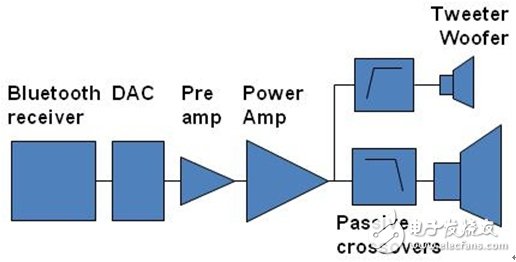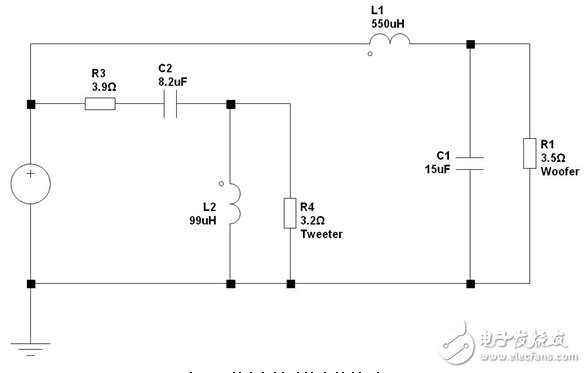In the hot download of the "Voice and Audio Technology Special Issue" in November, the electronic enthusiast network is missing. Current wireless active speakers have four components in the signal path before the driver, namely: receiver, DAC, amplifier, and divider. The receiver can be a Bluetooth device running a highly efficient codec; the amplifier may be a conventional analog input class AB device, with a high efficiency DAC through its input port guaranteeing a higher audio quality; and the last component on the signal path is passive Crossover network. Alternatively, we can use an efficient Class D amplifier to directly drive the high and low speakers by increasing efficiency. If a Class D amplifier has a digital input port, DSP resources can be used to implement an efficient digital divider, which is a great advantage over a passive divider. Active speaker architecture Figure 1 shows a conventional wireless active speaker architecture. The receiver is a Bluetooth device that runs an efficient codec such as aptXTM to ensure optimal audio performance. To facilitate conversion from the digital domain to the analog domain, the system needs to configure an efficient DAC before the amplifier input port. The preamplifier and power amplifier operate in the analog domain and the high and low speakers are driven simultaneously by a single power amplifier. Figure 1: Conventional Wireless Active Speaker Architecture Providing higher audio quality requires a Class AB amplifier architecture. However, analog input Class D amplifiers are very power efficient, which is very attractive; today's closed-loop analog input Class D amplifiers also provide good audio performance. Increasing efficiency also means saving power. In this architecture, the passive crossover network provides high-pass and low-pass filtering, which decomposes the audio signal into appropriate frequency bands for the high and low-frequency drivers. The emergence of ultra-efficient digital input Class D amplifiers makes another architecture attractive, see Figure 2. In this architecture, the audio signal stays in the digital domain until the amplifier's power stage is output. This is an audio performance advantage in itself—no need for a DAC for digital-to-analog conversion, eliminating conversion errors. Figure 2: Wireless powered speakers using digital input Class D technology For optimal audio performance, a closed loop digital amplifier is required. The platform in this example is the CSR Direct Digital Feedback Amplifier (DDFATM) technology. Under this architecture, the functions of the preamplifier and power amplifier are implemented in a single circuit. Although each driver requires an amplifier channel, the power level of each channel can be precisely adjusted based on the sensitivity of the high and low frequencies. In terms of frequency dividers, the available signal processing power can achieve great advantages. The on-chip DSP makes it easy to implement efficient filters that are configured to fully match the driver characteristics, eliminating the need for passive components. Passive frequency divider and active frequency divider Figure 3 shows the implementation of a typical passive crossover, which is discussed in more detail below. Figure 3: Implementation of the passive crossover This design uses a conventional second-order filter for each driver with a divider frequency of approximately 2.2 kHz. The bass impedance is 3.5Ω and the treble impedance is 3.2Ω. The circuit consists of a simple inductor and capacitor. Because it is on the power path, the inductor and capacitor must be relatively large. However, there is a possibility of loss of efficiency, resulting in heat dissipation and performance shift. As the power level increases, these effects deteriorate further, eventually resulting in a higher degree of distortion. Although the circuit design looks simple, the interaction of the components is very complex, so it is difficult to completely isolate the individual drivers. The characteristics of the driver vary with frequency, power, and temperature, and the response of the filter is directly affected by this. The divider adds a filler resistor to match the various driver sensitivities, which results in a further increase in heat dissipation. Therefore, it must be implemented correctly, otherwise the overpowered inductor will be saturated, causing distortion at high power, or even failing to destroy the tweeter. Charcoal BBQ Grill,Charcoal Smoker BBQ Grills,Charcoal Barbecue Grill,Charcoal Grill Shaoxing Haoda Electrical Appliance Co.,Ltd , https://www.zjhaoda.com
Consumers want to connect their home entertainment systems with as few cables as possible, thus creating a need for wireless active speakers. In order to provide the best audio quality through high-end active speakers, we can use a variety of techniques to improve its performance; in this case, digital active crossover can play an important role. 

